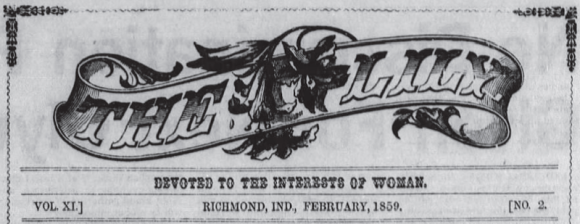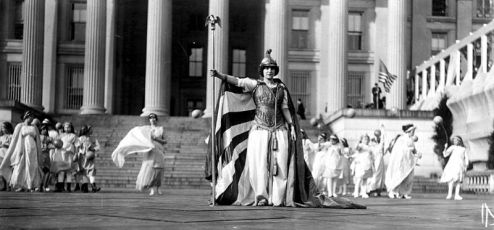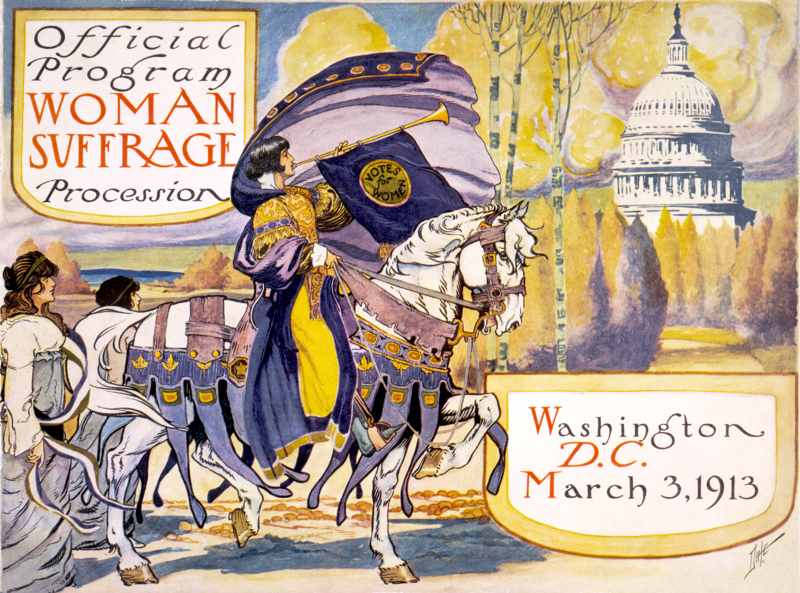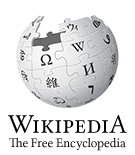By Eilene Lyon
A Major Milestone
This year we celebrate the 100th anniversary of the passage of the 19th Amendment to the U. S. Constitution. It was ratified in 1920, so we can celebrate another centennial next year. In recognition of women winning the vote, the National Archives (NARA) has a special exhibit opening in May.
In conjunction with that, NARA has partnered with Wikipedia to create a special course for Wiki Scholars to improve Wikipedia’s articles on the suffrage movement and women’s history/biography in general.
Bias in Wikipedia
English Wikipedians are overwhelmingly male and represent primarily North American and European populations. Consequently, there is a lot of bias on the platform. Biographies, particularly prior to 1900, are overwhelmingly about men. Meeting the “notability” requirement can be a hurdle for female subjects, partly because the notability standard at Wikipedia is defined by, um, men. See this article in Slate.
Why don’t more women write/edit Wikipedia articles? Some answers can be found here at the Harvard Business Review. The problem is widely recognized and many people are looking for ways to combat it. A couple good articles on the subject come from the Washington Post and Smithsonian. It’s also important to get more women of color in Wikipedia, not just in the suffrage movement, but for any significant achievement.
I created my own Wikipedia account over a year ago, because I wanted to correct some errors. But I never did much, because I didn’t feel like I really understood the platform. It looks more user-friendly than it seems once you get started.
Learning to Edit/Write for Wikipedia
In December, NARA sent me an email about the Wiki Scholar program and I jumped at the chance to learn how to be a Wikipedian while improving women’s suffrage articles. While it’s billed as a program for students and professionals in academia, it isn’t that restricted. You do have to apply and pay for the course (scholarships are available).
It’s been such a fantastic experience! The class is taught by two Wikipedia editors (and a guest appearance by someone from NARA). There are teaching modules to do on your own, plus once a week the entire class meets for an hour by video conference.
There is also regular communication with other students and course instructors using Slack and our Wikipedia user pages. I’ve learned new concepts from classmates and new terminology as well: “nonbinary person,” for example.
By the end of the 3-month course, Wikipedia expects each student will contribute significantly to at least two articles. First we learn to evaluate what makes a good Wikipedia article, so we can take steps to improve them. Work is usually done in a “sandbox,” a user sub-page that isn’t a live article, but is accessible to anyone. After an instructor provides feedback, the edits are copied to the actual article.
My Contributions

My first article was a biography about a 19th-century suffragist from Indiana, Mary Thistlethwaite Birdsall. Using my genealogy research skills, I was able to correct some information about Birdsall and add quite a lot more to this article. Not many people had worked on it, so I figured I wouldn’t get much resistance to my work (great for a newbie).
The second article was a much larger undertaking, which I also substantially re-wrote and expanded greatly. Beforehand, I engaged with the people who had previously worked on it. This one is about a significant historic event, the 1913 Woman Suffrage Procession in Washington, D. C. It was the first major political march in our nation’s capital.
While researching this article, I came across many women who either need substantial additions/revisions to their Wikipedia articles, or new ones created. I’ll never run out of projects! In researching both articles, I learned so much about the suffrage movement that I previously knew nothing about. Like all Wikipedia articles, these two are still works in progress.

Your Turn?
Two other things I learned in this class were: 1. how important it is to use a neutral tone (in Wikipedia, not my blog!), and 2. the subtle ways that the English language and composition are used to imply that women are subordinate or inferior to men. I recommend reading this article: Writing about women to see how we can be less biased.
Do you use Wikipedia? It seems like it’s the first place I go to learn about a person, historical event, natural phenomenon, or geographic place. Many people are working to make it reliable, but it depends on editors using quality resource materials. If you feel like giving back by contributing to this online encyclopedia, I hope you will consider signing up.
If you would like a mentor, contact me through this blog and I would be happy to help!
Resources:
Editing_Wikipedia_brochure_(Wiki_Education_Foundation)_(2016)
Illustrating_Wikipedia_brochure_(Wiki_Education_Foundation)
Feature image: Official Program for the 1913 Woman Suffrage Procession (Wikimedia Commons)


You’ve done a good marketing job here 👍. I use Wiki a lot and store articles for later reading in Pocket app, then the ones I want to keep for ancestry relevance I store clippings in Microsoft OneNote. But … I’d be scared stiff of writing something for them!
LikeLiked by 1 person
I can’t believe that! You obviously know how to research and summarize very well. You’d be excellent.
LikeLike
I use wikipedia as a starting place for much of my research. I didn’t know that there were trained editors, such as yourself, who wrote/corrected the articles. Interesting. I’ve kept the link to the article about how to write about women. No time to read it now, but later. Thanks.
LikeLiked by 1 person
I think most Wikipedians are self-taught, but they do have employees who spread the knowledge, too. There are lots of help pages, but I think it’s hard to know what to look for. Getting some tutorials one-on-one or in a class is better. There are editathons where people get together to learn and work on articles. This month there was a big one called Art + Feminism that had events all over the place. There was even one at the college here in Durango!
LikeLiked by 1 person
Great work! I’ve been to a couple of “Editathons” which had the specific intention of getting more women on Wikipedia both as editors and subjects. I wrote an article each time, but other than minor additions to pre-existing articles I haven’t done any more. It’s just finding the time to fit everything in! I was impressed to learn about the strict standards Wiki upholds though, it’s by no means the free for all some people think it is. I came away from the Editathons with a new respect for it.
LikeLiked by 1 person
Way to go, Anabel! No matter how big or small the contribution, it all matters. And the more women on board, the better!
LikeLiked by 1 person
Your blog makes me more comfortable about using Wiki. I’ve always tried to find a “more reliable” resource, but I’ve also thought it would be fun to fill in gaps–like internationally known people from my small hometown, since I already work with their museum.
LikeLiked by 1 person
That sounds like a wonderful project, Joy!
LikeLike
I am impressed at your wiki-dness. Wikipedia has become an awesome resource. There’s probably a reason they’ve never asked me anything. Hehe
LikeLiked by 1 person
LOL. Don’t ask, don’t tell? I’m sure you would have plenty of good stuff to contribute. You seem to read a lot of very interesting things.
LikeLiked by 1 person
Wow this is very interesting!! I definitely use Wikipedia for the broad strokes when I’m looking into something new. That’s awesome what you’re doing!
LikeLiked by 1 person
Thanks, M.B.! I’ll bet you could find some interesting women to write about on Wikipedia.
LikeLiked by 1 person
I had no idea that they offered courses. I applaud your desire to ensure the information reflects more accurately the contribution women have made historically! Okay, not sure that sentence is grammatically correct…!
LikeLiked by 1 person
Historically and presently, too! We’ve got a ways to go, but we’ll get there.
LikeLiked by 1 person
That’s terrific!! Thank you for your contributions. I really appreciate accurate information on the internet, so every little bit that anyone adds to the cause is wonderful!
LikeLiked by 1 person
Thank you!
LikeLike
You’ve got some wicked wiki knowledge there, Eilene.
There’s lots I didn’t know about Wiki, that now I do! Thank you kindly. 🙂
LikeLiked by 1 person
Thanks for reading. I aim to inform. 😉
LikeLiked by 1 person
Love it!
LikeLiked by 1 person
What a great post, Eileen! I didn’t realize how much I took Wikipedia for granted, never realizing all that went on behind scenes. Loved the article on writing about women, too. I think I’ll bookmark it as a reference.
LikeLike
What an enjoyable post! It was so interesting to learn how Wikipedia works behind the scenes, and knowing that people like you with actual research skills are contributors makes it feel more trustworthy! I’d definitely be interested in contributing at some point when I have a bit more time on my hands.
LikeLiked by 1 person
It definitely ended up taking a lot more time than they said it would!
LikeLike
Thank you for contributing to a great subject – women’s suffrage.Thank you, too, for being a dedicated wiki contributor. I often use Wikipedia.
LikeLiked by 1 person
Thanks, Linda. My pleasure.
LikeLike